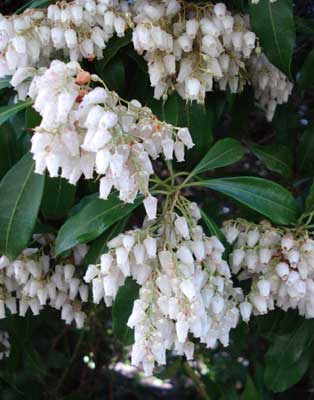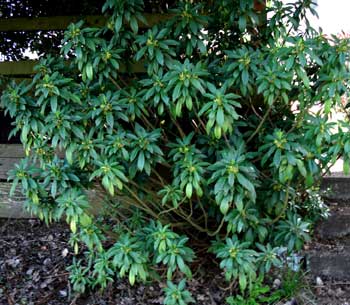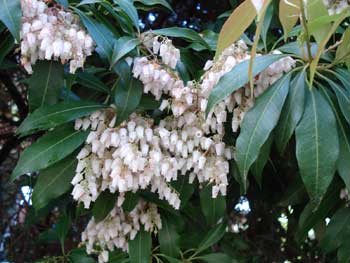
'White Cascade'
Japanese Andromeda
"Though a few belated snowflakes circled from a changing sky,
Every shrub & moss-lit boulder stirred responsive to the cry;
Swayed the blackwoods all a-shiver, dreaming by the snow-fed river,
Thrilled the gums with naked bosoms, ranked in stern battalions by:
Beautiful in caverns burning, swiftly came the Spring returning,
Musical from hill & valley came Demeter¼s happy sigh."
-Frank S. Williamson
(1865-1936)
Pieris japonica 'White Cascade' is an old standard andromeda or fetterbush cultivar, with large long-lasting panicles of droopy bell-shaped flowers, which lend it its alternate name Lily-of-the-Valley Bush, though the flowers are even more akin to those of blueberry bushes, being of the same heath family.(1865-1936)
Each individual bloom is perhaps three-quarters inch long or smaller, but hang in clusters to seven inches, & frequently much wider in a broad truss. While in bloom the foliage can very nearly vanish behind this spectacular show.
 It blooms spectacularly in partial to bright shade, though flowering will be reduced in too deep a shade. It likes conditions very similar to winter-blooming Camelia sasanqua, & if mixed with pink-flowering cultivars the flowering period can overlap to stunning effect.
It blooms spectacularly in partial to bright shade, though flowering will be reduced in too deep a shade. It likes conditions very similar to winter-blooming Camelia sasanqua, & if mixed with pink-flowering cultivars the flowering period can overlap to stunning effect.When it goes to seed the spent blooms snap off quite easily if one wishes to "dress" the shrub, but if ignored the seedy trusses are not unattractive, & they will eventually drop off on their own so that by the following spring new flowers will not share the shrub with old brown flowers.
The leaves of Pieres are toxic to livestock, & deer avoid it. The leaves of 'White Cascade' do not have the late-winter early-spring "red leaf" showiness of hybrid cultivars like 'Mountain Fire,' but it is vastly hardier for a neglectable landscape area. It is drought-hardy once established, though it'll need regular irrigation in well-draining soil its first couple years, after which it will thrive in conditions that would certainly kill the likes of 'Mountain Fire.'
Personally I am not highly enamored of andromedas -- strictly a matter of preferences -- so I have none in my own gardens. The specimen shown here is in the alley directly across the street from the Garden of Paghat the Ratgirl, where I can enjoy it in all its seasons without it taking up space in my own yard. In its location it is shaded by rose bushes on the sunny upper hillside & by one large tree.
It is on the ledge of a steep dry hillside where it gets very little water, which might well kill a more sensitive cultivar. Yet 'White Cascade' never shows signs of being burdened by the droughtiness, though it probably would've done so when it was newly planted over a decade ago, or if it were in brighter sun.
 It's ideal for zones 7/8, but if grown at colder elevations or further north in Zone 6, it's more resistant to frost damage than are most pieris cultivars, though it will need some protection, such as in a shady location where desiccating winter winds won't injure its strongly evergreen foliage.
It's ideal for zones 7/8, but if grown at colder elevations or further north in Zone 6, it's more resistant to frost damage than are most pieris cultivars, though it will need some protection, such as in a shady location where desiccating winter winds won't injure its strongly evergreen foliage.It wants slightly acidic humus-rich soil, & not too much sun or its leaves may scorch at high summer. An old shrub may find itself in soil that has become less loamy with time, but it's not feasible to cut into the root system to restore loaminess & acidity. Rather, a seasonal (autumn) mulch of pine or fir needles will help re-acidify the soil, while worms do the chore of bringing some of the decaying mulch into the soil.
Though in great old age it can be quite a large shrub, its compact habit & slow growth rate means it'll be only about four or five feet tall in ten years, equally wide & naturally roundish if rarely or never pruned.
The species can grow much larger where it grows native to Japan, Taiwan & Eastern China. The purely wild form is discussed in a separate article, together with notes on associative mythology.